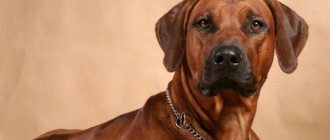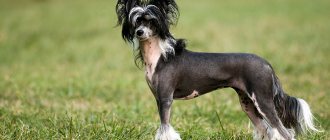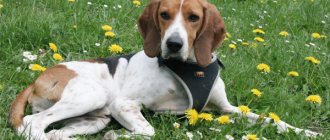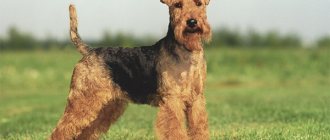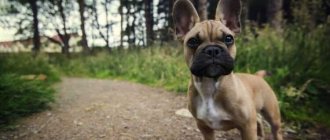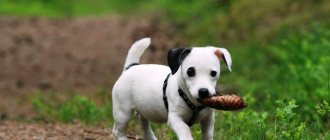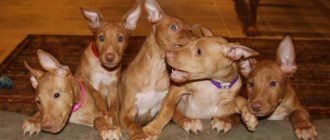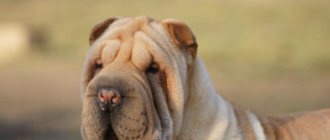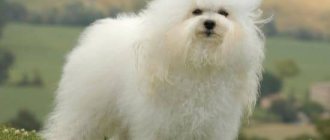The true Ridgeback is magnificent security guard, possessing innate vigilance and sensitivity, allowing him to instantly respond to an alarming situation.
In addition, he is a non-aggressive bodyguard who never engages in combat unless absolutely necessary, requires little or no special training, and is a devoted family friend and children's favorite.
The ability to follow the scent and hunt, they can follow the trail both in the air and on the ground. They have excellent vision and a broad outlook. If German shepherds are afraid to come face to face with three or more opponents in the forest, then Ridgebacks control the entire open space, and this determines their decision - either to lead their owner out of a dangerous situation, or to go behind the rear of approaching enemies in order to disperse them. Some Ridgebacks have shown by their own example that they do not need special training, since they already perfectly participate in the show, follow the scent and obey the owner.
This is a self-confident dog who is well aware of his abilities. As soon as something new happens, the Ridgeback's dark eyes immediately light up with curiosity. Never mistreat your Ridgeback. Although we generally avoid giving dogs human characteristics, I can guarantee that the Ridgeback has excellent long-term memory. Treating him well will make you a most loyal friend. All he asks in return is the same loyalty, as well as respect for his integrity. When you think the Ridgeback's independent arrogance is going too far, remember that this is a proud dog with a lot to be proud of.
The Ridgeback's vast range of activity is concentrated between surprising extremes:
- on the one hand, the speed of reaction , which allows you to instantly dodge danger, on the other, indifferent slowness , when nothing interesting happens around;
- on the one hand the strength necessary for a farm dog to repel the attacks of people and animals, on the other, the incredible ease of movement that allows it to run mile after mile without fatigue.
Not a single horse ride of the owner will be too long for the Ridgeback, and he will always calmly run after the horse. Finally, the fierce courage that flares up when the owner is in danger is combined with gentle devotion to his friends and especially children. In fact, the only way to describe such a combination of remarkable power, quick movement, endurance and explosive alertness is to use the word balance.
The overall impression of the Ridgeback is elegance combined with an awareness of its own strength. It can be said that if you examine a dog and do not find it perfectly balanced, then it is not a Ridgeback. There is no doubt that the male, with all his muscles, every inch of which guarantees speed and agility, is slightly stronger than the female. However, with all his power, he will never reach the stage where strength will prevail over speed. Accordingly, bitches, despite all their elegance, are not devoid of well-developed muscles. Ridgebacks also have a herding instinct, although it is less developed than the hunting and guard instinct. However, this will not prevent an almost untrained Ridgeback from chasing a deer or other large animal. Fortunately, Ridgebacks rarely attack or injure large animals unless specifically trained to do so, although small prey, such as a hare, sometimes becomes an irresistible hunting temptation, especially for bitches. Ridgebacks are known to be able to form small packs of three or four dogs to track and kill wild boars.
Owning such a fast, strong and sensitive dog requires absolute control on the part of the owner. This breed is too good to fall into disrepute simply because the owner does not understand the true nature of his pet. The Ridgeback is a natural dog and therefore requires appropriate handling. This is not a lapdog or a toy for those who are afraid of physical activity and do not like nature.
An ideal breed for people who are able to appreciate the full range of its abilities and capabilities, including sociability, and are ready to become the owner of a dog with strong roots in the wild.
The Ridgeback owner must have complete control over his pet.
The only way to completely control a Ridgeback is to earn his complete trust and respect.
Stig G. Carlson "Rhodesian Ridgeback"
Brief history of origin
The first mention of Rhodesian Ridgebacks appeared around three thousand years BC. e. in Egypt. In the 1st century AD, they were already quite common in Ethiopia, where local residents used them to protect their flocks of sheep from lions, hyenas and other predators. The Hottentots took their faithful helpers with them when they migrated to southern Africa in the 5th century.
When European colonialists arrived in the countries of Southern Africa at the end of the 17th century, they were delighted with the strong and hardy South African dogs. Their distinctive feature was a comb of wool that stood out on their back. Europeans began to cross them with the hunting and guard dogs they brought with them.
The best qualities and vitality were passed on to offspring with a stripe of wool on the back. Then, for 200 years, selection was carried out taking into account this characteristic feature.
Interesting! A special role in the selection of Rhodesian Ridgebacks is played by Van Rooyen, who decided to breed the ideal dog for hunting lions. To do this, he crossed the African breed of dogs with Great Danes, Pointers, Mastiffs and Bloodhounds.
In different parts of Africa, the selection of Rhodesian Ridgebacks was carried out in two directions.
- Descendants of colonists from France, Germany and Holland attached greater importance to protective qualities. Therefore, the blood of mainly mastiffs was “poured” into local dogs.
- Descendants of British colonists crossed African dogs with hounds and hunting breeds.
This explains the variety of exteriors of modern Ridgebacks.
Ridgebacks, which were brought from Rhodesia, first appeared in Europe in 1877. The first official breed standard for the Rhodesian Ridgeback was developed in 1922 by Francis Richard Barnes. However, the breed was officially recognized only in 1924. In Russia, the first club was opened only in the 90s of the 20th century, but its representatives very quickly reached the world level and began to take prizes at international exhibitions.
The definition of the Rhodesian Ridgeback as a “lion dog” gave rise to the myth that in a fight with the king of beasts he will certainly win. However, this is a misconception, since representatives of this breed never engage in open combat with a lion.
Rhodesian Ridgebacks only track down predators, collect them in groups of several individuals, drive them away or hold them in place until the hunters arrive.
Health and illness
The Rhodesian Ridgeback breed, bred in South Africa, is characterized by good health. Under the influence of the external environment, only the strongest individuals were able to survive, which became the ancestors of today's dogs.
The main diseases that can affect dogs are as follows:
- Hip dysplasia is a classic disease in almost all large breeds.
- Glaucoma, entropion and cataracts.
- Obesity.
- Deafness.
- Osteochondrosis, manifested in older representatives of the breed.
Lifespan
Dogs from Southern Rhodesia, with proper care, are able to give their owner love for 12-14 years. The average life expectancy is 10-12 years.
IMPORTANT! You should not overfeed your Ridgeback. This threatens the early death of the animal.
Interesting Facts
There are legends about the fearlessness of the Rhodesian Ridgeback dog. Indeed, representatives of this breed are capable of driving a lion, whose weight is about 400 kg, up a tree.
Hottentot dogs were much smaller in size. This is proven by archaeological excavations in the floodplain of the Orange River, which were carried out by Professor von Schulmoth. Thanks to the silt, the remains of the dogs were well preserved, and scientists were able to identify wheat-red fur with a characteristic ridge along the spine.
Similar remains were discovered on Phuc Oc Island (Vietnam). However, there is still debate about the origin of this branch of the breed.
George McColehill gave a fairly clear description of the Hottentot dog breed. The historian wrote that he saw terrible creatures whose bodies resembled jackals. On their backs there was a clearly visible strip of fur growing in the opposite direction. But for all their ugliness, dogs were distinguished by selfless devotion to humans, and were excellent guards, helpers and hunters.
A landmark event for the breed was the opening of the first Rhodesian Ridgeback kennel, Eskalde, by Richard Barnes on March 16, 1926. At first, only 6 dogs were registered in it. But their descendants are still found in modern lines of the breed.
In Russia, the first litter of Rhodesian Ridgebacks was born on November 1, 1994 in the Verbus kennel. A few years later Milady appeared in it, who became the European champion and vice-world champion.
Breed description, standards, appearance
The Rhodesian Ridgeback is a muscular, active dog with a harmoniously developed body. A male dog with a large, heavy body should not have a small head, just as a light female dog with a large head is also considered unbalanced.
Sizes and constitution of the Ridgeback
The height of a male Rhodesian Ridgeback should be from 63.5 to 68.5 cm, and that of a female – from 61 to 66 cm. The ideal weight for a male is 36.5 kg, and for a female – 32 kg. The permissible deviation is 2.5 kg up or down.
Head
When examining the head, the following parameters are assessed:
- wide flat forehead;
- flat cheekbones;
- subtle frontal sulcus;
- clearly visible transition from forehead to muzzle;
- the nose is uniformly colored black or brown;
- the bridge of the nose without a hump or deflection;
- lips are dry, their pigmentation matches the color of the nose;
- well developed jaws with a correct scissor bite;
- wide-set round eyes;
- eyelids tightly fitting to the eyeballs;
- triangular ears that taper towards the ends and fit close to the head.
Black-nosed Rhodesian Ridgebacks should have black or dark brown eyes, while brown-nosed ones should have amber eyes.
Breed disadvantages include:
- wrinkles on the forehead;
- clearly visible occipital protuberance;
- pink or gray color of the nose;
- malocclusion;
- hump or depression on the back of the nose;
- a straight line from the occipital protuberance to the nose;
- jowls that are too saggy;
- bulging eyes.
Neck
The well-developed, muscular neck tapers towards the base of the head and has a slight curve at the top. The length of the Rhodesian Ridgeback's neck should be half the length from the withers to the first caudal vertebra to allow free rotation of the head.
A short neck and the presence of a dewlap are considered disadvantages of the breed.
Shoulders and chest
The length of the humerus of the Rhodesian Ridgeback does not exceed the length of the shoulder blade. The protruding edges of the scapular bones are separated from each other by the width of a vertebra.
The protrusion of the sternum is clearly visible both from the side and from the front. The chest of the Rhodesian Ridgeback should not be excessively wide, so as not to create an imbalance with the rest of the body (this is especially true for females).
A disadvantage of the breed is considered to be an overly protruding sternum.
Frame
The chest is deep and descends to the elbow joint; the ribs are well arched and directed backwards. The back of the Rhodesian Ridgeback is strong, wide and horizontal with a slight bend in the lumbar region.
The disadvantage of the breed is the barrel-shaped ribs, which reduce the speed of movement.
Limbs
The forearms are straight and oval in cross-section and fit tightly to the body in the area of the elbow joints. Strong pasterns slightly sloping.
The shins of Rhodesian Ridgebacks are well developed and pronounced, with short and parallel metatarsals when viewed from behind. Compact paws have arched toes and round, elastic pads between which hair grows.
A serious fault of the breed is considered to be a “hare’s” foot, when the pads are loose and not gathered into a ball. Also a serious defect is sabering or other curvature of the metatarsus. These defects prevent Rhodesian Ridgebacks from hunting for a long time and often lead to injuries.
Tail
The tail has no bends. Thick at the base, it gradually tapers towards the tip and reaches the hocks. When moving, the tail of the Rhodesian Ridgeback bends slightly upward, but does not curl into a “donut”.
A tail that has broken vertebrae or hair that is too long is considered a fault. Ridgebacks with a short or rough rat-like tail, which disrupts the animal's balance during sharp turns, are also subject to rejection.
Color and coat type
According to the standards, the color of the Rhodesian Ridgeback can vary from light wheaten to red wheaten. The body, head and tail are evenly colored, but there should be areas of lighter colors behind the shoulder blades, on the neck and back of the thighs.
Darkening on the face and ears, as well as white markings on the chest, are considered acceptable. The disadvantages of the breed are black ears and white markings on the limbs above the toes.
The ridge deserves special attention. It originates just behind the shoulder blades, gradually narrows and ends at the hip joints. The stripe of the comb of the Rhodesian Ridgeback is clearly visible, and the hairs on it lie smoothly.
Important! The curls of the ridge should be the same and clearly opposite each other.
Since the ridge is the defining characteristic of the Ridgeback, it is judged very strictly. And any deviations from the standard are considered gross breed defects.
The vices of the ridge are:
- additional curls;
- lack of symmetry;
- strip length mismatch;
- sticking hairs.
Ridgeback Health and Lifespan
By nature, Rhodesian Ridgebacks are endowed with excellent health. With proper care, the average life expectancy is 12 to 15 years. However, dogs of this breed have a genetic predisposition to such a rare disease as dorsal dermoid sinus.
The disease is an abnormality of embryonic development of Rhodesian Ridgeback puppies, which is characterized by incomplete separation between the skin (dermis) and the neural tube.
The sinus has one or more openings that are filled with tufts of hair, keratin or sebaceous gland secretions. The danger is that the sinuses can become inflamed. In their place, cysts and fistulas can form. If these formations are located in close proximity to the spinal cord, then there is a possibility that the Ridgeback will develop meningoencephalitis.
Important! Dermoid sinuses can be diagnosed in Rhodesian Ridgebacks by palpation and then removed surgically.
Another genetic condition that can be passed on to Ridgeback puppies is hip dysplasia. Therefore, when purchasing a puppy, it is worth finding out whether this pathology occurred in its immediate ancestors.
It is also important to ensure that Rhodesian Ridgebacks do not become overcooled in winter in the harsh climate of certain regions of Russia. Representatives of this breed do not have an undercoat that protects them from frost. Therefore, it is worth taking care of clothes for your pets during long walks.
Rhodesian Ridgebacks, like most other breeds, are susceptible to dangerous infectious diseases, which include canine distemper, enteritis, hepatitis and rabies. Therefore, puppies should be vaccinated according to the instructions for the vaccine used.
In most cases, the first vaccination is given at two months of age. Deworming and treatment against ectoparasites are carried out 10–14 days beforehand. The rabies vaccination is administered to Rhodesian Ridgeback puppies at the age of 6 months, followed by an annual booster vaccination.
Character and behavior of the Rhodesian Ridgeback
The Ridgeback's character is characterized by calmness and restraint. He loves to spend hours basking in the sun, in front of the fireplace or on the sofa. At the same time, it can instantly leave the state of contemplation or sleep at the first request of the owner. The dog is happy to be involved in active games with the owner, participates in exhibitions, dog racing and obstacle courses (agility). But daily monotonous walks along the same route are not to the taste of Ridgebacks.
Another character trait of the Rhodesian Ridgeback is its strong will. If the owner turns out to be morally weaker, and the dog does not recognize him as a leader, then the animal will become uncontrollable.
Important! Human dominance should never manifest itself in the form of physical violence. Ridgeback does not forgive such an insult, and instead of the expected obedience, the owner will receive the completely opposite result.
Breed and other animals
Rhodesian Ridgebacks are hunters by nature and see other animals as prey. If the dog is not sufficiently socialized and trained, then the owners may have problems. Therefore, you should not lose your vigilance while walking and avoid any contact.
However, if a Rhodesian Ridgeback puppy grows up in the same home with another pet, then in most cases they get along well with each other.
Breed and children
Rhodesian Ridgebacks get along well with children. They endure all their pranks and “noise effects” without complaint, especially if the puppy and child grew up together. However, one should take into account the fact that even a well-meaning dog may miscalculate its strength and cause pain to the baby. Therefore, it is worth following common sense and not leaving the baby alone with the animal.
Education and training
Briefly about training Rhodesian Ridgebacks: it is difficult, but possible if the training is preceded by a preparatory stage, after which the animal will be more attentive to the owner’s requirements. For example, it is very important to awaken your pet's interest in toys, since Rhodesian Ridgebacks love to play with each other, and not with inanimate objects. In addition, toys are a good help in cases where the puppy needs to be distracted, for example, from biting the owner’s hands. However, you shouldn’t overdo it with entertainment either: the game should not be protracted and tire the animal. Decide on the boundaries of what is permitted. If you plan to relax on the sofa cuddling with your pet, it’s enough to sit your tiny Ridgeback on it a couple of times. Those who are not yet ready to share a bed with a pet, but still an animal, will have to guard soft horizontal surfaces like the apple of their eye. Once your baby lies on the sofa, he will always practice this, especially in your absence.
Establishing tactile-emotional contact between a person and a puppy also refers to the preparatory stage of training. Teach your baby not to be afraid of your touch, sit him next to him more often, lift him up, passing your hand under his stomach. Command “Come to me!” It is not used for 3-month-old babies, but the pet must answer the owner’s call. If this does not happen, you will have to be cunning by luring the dog with a treat and loudly pronouncing its name. Gently introduce your Rhodesian Ridgeback to the leash. At 3-4 months, the puppy should adequately perceive this accessory and not go crazy when a collar appears on it.
When training, take into account the characteristics of the breed. The Rhodesian Ridgeback has a somewhat scattered attention, so long-term concentration on one subject is torture for him. Reduce the duration of lessons as much as possible (the best option is no more than 5 minutes) and increase breaks (from 10 minutes or more). Don’t forget to monitor your pet’s mood: if the dog shows obvious boredom at the very beginning of training, training will have to be temporarily stopped.
The Rhodesian Ridgeback's attention can and should be trained, which will then make working with him much easier. The classic technique for fixing this property of the psyche looks like this: the owner treats the dog with a treat, after which he squeezes the rest of the treats in his fist, raising his hand high up. An interested puppy will immediately try to get the object of gastronomic desire, jumping up and hypnotizing the person’s hand with his gaze. When attempts to get the delicacy are unsuccessful, the Rhodesian Ridgeback will use the last resort - it will look pitifully at the owner. It is necessary to hold the puppy’s gaze for as long as possible, after which the “sufferer” should be given a good treat.
Cynologists recommend starting to practice basic commands with the Rhodesian Ridgeback at 4-5 months. By this age, the puppies have become relatively stronger and more independent. How advisable it is to learn all the commands from the General Training Course is up to everyone to decide for themselves, but the call “Come to me!” and the ban "Ugh!" The Rhodesian Ridgeback is a must learn. Otherwise, the dog's life will be very short.
As for methods of education and training, representatives of this breed are more suitable for positive reinforcement, and this does not necessarily have to be a treat. Among Rhodesian Ridgebacks there are real gambling addicts, for whom the best incentive is the opportunity to chew on their favorite toy. Other dogs are content with their owner's praise and a pat on the head. Negative reinforcement also has its place in the life of the Rhodesian Ridgeback, but it should be used in exceptional cases, when the animal demonstrates a clear disregard for the rules or tries to measure strength with a person. No, hitting your pet is strictly prohibited, but patting him by the ear, pulling his collar or throwing him on his back, pressing him to the floor, is quite acceptable. It is very advisable to accompany the “execution” with a verbal prohibition, for example, with the command “No!” And please, no spanking with a wet towel, lashing with a twig or other offensive physical influences. Such humiliation will remain in the Rhodesian Ridgeback's memory for a long time and will significantly undermine your authority in his eyes.
Important: do not place excessive demands on the animal. Rhodesian Ridgebacks have never been working dogs and will never be. They are smart and trainable, but perfect adherence to commands cannot be achieved from these stubborn people. So be prepared for the fact that even a mature animal will periodically experience “system failures” when the pet ignores your order.
How to choose a pet
When purchasing a Rhodesian Ridgeback puppy, you must follow these rules:
- make sure that the selected nursery is registered in the RKF;
- give preference to a country nursery with free range;
- choose a puppy from a mother who gave birth at least a year ago;
- refuse to buy a puppy if the breeder cannot provide complete information about its parents.
Important! Those who are getting a Rhodesian Ridgeback for the first time should know that the comb on puppies is noticeable already in infancy. The claim that the ridge will grow back over time is a deception and a ploy by dishonest breeders to sell a “defective” baby.
It is also worth paying attention to the number of puppies in the litter. It is best if there are no more than 6 of them. Moreover, all babies should be the same size and fatness.
Important! In elite nurseries, female Rhodesian Ridgebacks produce no more than 2–3 litters in their entire lives.
The optimal age for purchasing a Rhodesian Ridgeback puppy is 1.5 months. In this case, after making a deposit, a purchase and sale agreement is drawn up between the breeder and the owner.
The breeder is obliged to issue a puppy card (metric), which contains information about the puppy, breeder and owner, as well as a veterinary passport. It will contain information about all treatments and vaccinations throughout the pet’s life. Without this document, it is impossible to cross the state border and participate in any events.
When the Ridgeback reaches the age of 15 months, the metric changes to a pedigree with the emblem of the federation. To do this, the metrics should be submitted to the RKF from 9 to 15 months.
Important! To participate in exhibitions and tournaments within the country, a pedigree in Russian is suitable. To participate in international competitions, you need a document filled out in Latin script.
In addition to documents, a purebred Rhodesian Ridgeback must have a brand, which is applied to the inner surface of the right ear or in the groin area. Its number and code must be registered with the RKF. Additionally, a microchip is implanted under the dogs’ skin, on which all information about the animal is recorded.
Care and maintenance
Both a country house and a small city apartment are suitable for a Rhodesian Ridgeback to live in. But a prerequisite is long daily exercise and a sufficient amount of physical activity. But keeping in an enclosure or on a chain is categorically unacceptable for this breed of dog.
Hygiene procedures
To keep the coat in order, it is enough to brush your Rhodesian Ridgeback once a day with a special mitten or a natural bristle brush. To keep your house clean during seasonal shedding, this can be done 2-3 times a day.
You should bathe your Ridgeback with shampoo or special soap for animals no more than 2-3 times a year. If your dog's fur gets dirty during a walk, it can be washed with clean water without detergents.
Paws should be washed and inspected for damage after each walk.
Important! In winter, breeders recommend using dry shampoos to avoid hypothermia in the Rhodesian Ridgeback.
During long walks, Ridgebacks' claws wear down, so they do not require additional care. To keep teeth clean and prevent the formation of tartar, dogs should be given hard bones or special biscuits to chew on.
Rhodesian Ridgebacks do not require special ear care. Whenever they become dirty, it is enough to wipe them with a damp cotton swab.
The eyes also do not require special care. But if they begin to water or sour, then you need to contact a veterinarian to determine the cause and carry out proper treatment.
Feeding
Rhodesian Ridgebacks are prone to allergies, so the diet must be selected carefully. After feeding new products or ready-made food, you should monitor the well-being and condition of the pet’s skin.
Important! You can consult with the breeder about feeding the puppy.
The owner initially needs to decide on the type of diet. The Rhodesian Ridgeback should be immediately accustomed to industrial feed or natural products.
Important! Simultaneous feeding with natural and ready-made industrial feeds leads to gastrointestinal upset, the appearance of allergic reactions, and the development of liver and kidney pathologies.
The number of feedings per day is determined by the age, physiological state of the puppy and conditions of detention.
| Age | Number of feedings |
| 1–2 months | 5–6 times |
| 2–4 months | 4–5 times |
| 4–6 months | 3–4 times |
| 7–12 months | 2–3 times |
| More than a year | 2 times |
Industrial diet
To ensure full and harmonious development of a Rhodesian Ridgeback puppy, he should be fed high-quality holistic or super-premium food. They contain all the nutrients, vitamins and minerals dogs need, but are free of gluten, flavors, preservatives and cheap fillers. Also, these foods are hypoallergenic.
Rhodesian Ridgeback puppies should be fed wet food or dry food soaked in warm water until they are three months old. Then you can transfer only to dry food, but at the same time provide a sufficient amount of clean drinking water.
For pregnant and lactating females, manufacturers offer separate diets that meet the increased needs of the animal's body for vitamins and minerals. Therefore, additional additives should not be introduced.
Also, special food is intended for sterilized animals.
Important! Holistic food does not contain a line of diets for dogs that suffer from certain pathologies. Manufacturers claim that feeding their products to puppies from infancy will prevent the development of diseases, and the animals will live a long, healthy life.
Natural feeding
Rhodesian Ridgebacks do not suffer from lack of appetite and therefore never refuse supplements. However, this weakness cannot be indulged, since these dogs are prone to obesity even with sufficient physical activity.
The basis of the diet should be proteins. For 10 kg of live weight of a pet, you need to give from 80 to 100 g of protein. Ideally, you should choose lean beef or lamb.
Important! Despite the fact that chicken is a dietary meat, it very often provokes allergies in dogs. Therefore, it should be included in the diet of Rhodesian Ridgebacks no more than 1–2 times a week.
Owners need to know which foods are healthy for their pets and which are strictly prohibited to feed.
| Healthy foods | Prohibited Products |
| Sea fish (boiled, boneless) | River fish |
| Natural fermented milk products with medium fat content | Cabbage, potatoes, fruits (except green apples), sorrel, spinach |
| Quail and chicken eggs (once a week) | Sweets, baked goods, chocolate |
| Zucchini, broccoli, carrots, greens | Smoked meat and fish products |
| Vegetable oils | Canned food for people |
| Low-fat cheeses | Fried and salty foods |
| Unleavened bread crackers | Garlic and onion |
| Cereals: rice, barley, buckwheat | Cream, whole milk |
Important! Unfortunately, you can still hear the advice of “experienced” dog breeders that dogs should be periodically given garlic to prevent helminthiasis. But this causes burns to the mucous membrane of the gastrointestinal tract in Rhodesian Ridgebacks, and leads to poisoning in puppies.
As a treat and reward during training, you can give special biscuits or cookies that are intended for dogs. Pets should also be given bones (not tubular) and cartilage.
Important! It is prohibited to introduce additional vitamin and mineral supplements into the diet of Rhodesian Ridgebacks without consulting a veterinarian.
If the owner is not confident in his abilities when preparing a diet for his Ridgeback, it is worth contacting a veterinarian or an experienced breeder.
With any type of diet, Ridgebacks should always have access to an unlimited amount of drinking water.
Walking and exercise
A short quiet walk on a leash is absolutely not suitable for the Rhodesian Ridgeback. Dogs of this breed need intensive walks of at least 3-4 hours a day with the ability to run without a leash, overcome obstacles and follow the owner’s commands, which require physical and mental stress.
Training and education of the Ridgeback
Raising a Rhodesian Ridgeback puppy should begin from the first day it arrives in the house. At the initial stage, it is necessary to accustom the baby to cleanliness, knowledge of his place and where to eat.
Training a Ridgeback puppy begins at 2 months of age and takes place in 3 stages:
- From 2 to 3 months. Developing the attachment of a Rhodesian Ridgeback puppy to its owner with the help of treats, voice intonation, touch and encouragement in the form of toys. Also at this stage you should accustom your baby to a leash.
- From 3 to 4 months. Completing the initial training course (sit, lie down, move next to you, know your own place) in a playful way without punishment and excessive persistence. At this time, you can begin to teach the puppies to perform tricks such as moving backwards and turning under the arm. All activities should bring pleasure to the dog and the person. When the owner notices that the Ridgeback is losing interest in activities, they should stop and take a break.
- From 4 to 5 months. Socialization of a dog in three directions: other animals, people, man-made factors. The goal of socialization is the Ridgeback's ability to maintain focus on its owner in any situation and in the presence of distractions.
Ideally, educational training should be completed by 5-6 months of age. If you start it after 6 months, it will take more time and effort, but it will also end in a positive result, provided that it is approached correctly.
Only an experienced dog handler should train an adult Rhodesian Ridgeback.
Basic moments
- They are the only South African breed to be officially recognized by the FCI.
- Rhodesian Ridgebacks cope excellently with most canine professions, naturally looking like watchdogs, hunters and companions.
- The breed's strong chasing instinct makes it dangerous to other pets, including cats. If the Rhodesian Ridgeback is pointedly indifferent to the cat walking in the distance, then in 99 cases out of 100 this purr grew up with him.
- The name of the breed is formed from two words: Rhodesia - the territory of today's Zimbabwe, where the first appearance standard for dogs was approved, and ridge - translated from English as “comb”, “ridge”.
- Rhodesian Ridgebacks are hardy and fast animals that are suitable for such sports disciplines as agility, coursing, ski- and bikejoring.
- Rhodesian Ridgebacks are not very talkative and only speak when they want to attract the attention of others to some phenomenon or event.
- The breed has good learning abilities, but during training its representatives often demonstrate stubbornness, testing the strength of the trainer’s authority.
- The Rhodesian Ridgeback is an intelligent dog, prone to leadership and living according to the laws of the pack, so it will be difficult for an inexperienced owner to find an approach to it.
- Rhodesian Ridgeback females are distinguished by a more domineering character and easily subjugate the males with whom they share living space.
- Rhodesian Ridgebacks have a reputation for being undaunted, brave and protective, although among them there are truly timid individuals that are driven to flight by any shout.
- Despite the fact that the breed has always been considered a hunting breed, its representatives easily abandon their historical purpose, willingly exchanging it for sports training and active games on the street.
The Rhodesian Ridgeback is a charismatic native of Africa with an oblong “mark” on its back. Fans of the breed attribute a lot of advantages to their charges, including high intelligence, fantastic resistance to stress, the ability to correctly assess the situation and act according to the circumstances, without regard to the owner. However, even taking into account the listed qualities, the portrait of the breed will be incomplete without mentioning the amazing energy of its representatives. It is the passion for an active lifestyle, combined with an innate desire for independence, that turns the Rhodesian Ridgeback into quite demanding pets that require increased attention and dedication from the owner.
Puberty and mating of Rhodesian Ridgebacks
The first heat of the Rhodesian Ridgeback begins between the ages of 6 and 12 months. However, experienced breeders do not recommend breeding a female before two years of age, since the animal must have enough strength to bear and feed a large litter.
To preserve the purity of the breed and ensure the puppies have a good pedigree, it is necessary to choose a pair for mating only in a trusted nursery. This also minimizes the risk of genetic abnormalities in the offspring that are inherited.
If the owners do not intend to breed Rhodesian Ridgebacks, then they should consult a veterinarian and have them sterilized. In addition to relieving the female of problems with sexual desire, this operation minimizes the development of cancerous tumors of the mammary glands and automatically eliminates their formation on the reproductive organs.
Important! It has been proven that drugs that are used to suppress sexual estrus in females, in most cases provoke the growth of malignant tumors. Therefore, sterilizing a Ridgeback is the most humane and safe way to solve the problem.
Pros and cons of the breed
Before purchasing a Rhodesian Ridgeback, you need to carefully study all the pros and cons of this breed, as well as “try on” the role of its owner.
The advantages of the Ridgeback include:
- possibility of living in a city apartment;
- love and devotion to the owner and his family members;
- restraint;
- “silence” (ridgebacks bark only when absolutely necessary);
- ease of care.
The disadvantages of the breed include:
- the need for long daily walks;
- difficulty getting along with other pets;
- training difficulties that arise due to the independent nature of the Ridgeback.
Ridgeback is absolutely not suitable for an unbalanced or weak-willed person whose character lacks the qualities of a leader. Also, representatives of this breed should not be owned by owners who use physical punishment as an educational element.
In response to humiliation and pain, the Ridgeback can become aggressive or become completely uncontrollable.
Breed characteristics
- Aggressiveness: Low ( Overall score
2/5) - Activity: Very high ( Overall score
5/5) - Training: Average ( Overall score
3/5) - Shedding: Minimal ( Overall score
1/5) - Need for care: Low ( Overall score
2/5) - Friendliness: Friendly ( Overall score
4/5) - Health: Average ( Overall score
3/5) - Cost of maintenance: Expensive ( Overall score
5/5) - Attitude towards loneliness: Moderate time ( Overall score
3/5) - Intelligence: Very smart ( Overall score
5/5) - Noise: Almost inaudible ( Overall score
1/5) - Security qualities: Average ( Overall score
3/5)
Rhodesian Ridgeback price
The cost of a Ridgeback varies depending on the animal’s age, health, appearance, pedigree, and kennel (breeder) rating.
In elite nurseries, the price for puppies ranges from 40,000 to 80,000 rubles. For amateur breeders, this amount ranges from 20,000 to 30,000 rubles.
For a nominal fee, you can purchase a Rhodesian Ridgeback from owners who have not met the requirements for such pets. You can also buy cull puppies for 2–3 thousand.
Sadly, Rhodesian Ridgebacks can even be found in shelters for abandoned animals. And for owners who put the animal first, and not its pedigree, this is a great opportunity to find a reliable and loyal friend.
How to buy a puppy
The price of the Rhodesian Ridgeback is relatively low.
- Copies without documents will cost 10-25 thousand rubles.
- Puppies with documents - from 25 to 80 thousand rubles. It is better to pick up puppies a little later than usual - at 2.5-3 months.
At an earlier age, young people actively frolic with each other. If there is no playmate of the appropriate size, there is a strong risk that the owner's leg will become that playmate for some time.
The Rhodesian Ridgeback is a descendant of lion hunters, with all that it implies. This is a real find, a wonderful companion and friend, but only if you regularly invest in his upbringing.
Best suited for middle-aged people, single or married, balanced people looking for business qualities, responsiveness and unconditional devotion in a dog.
